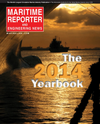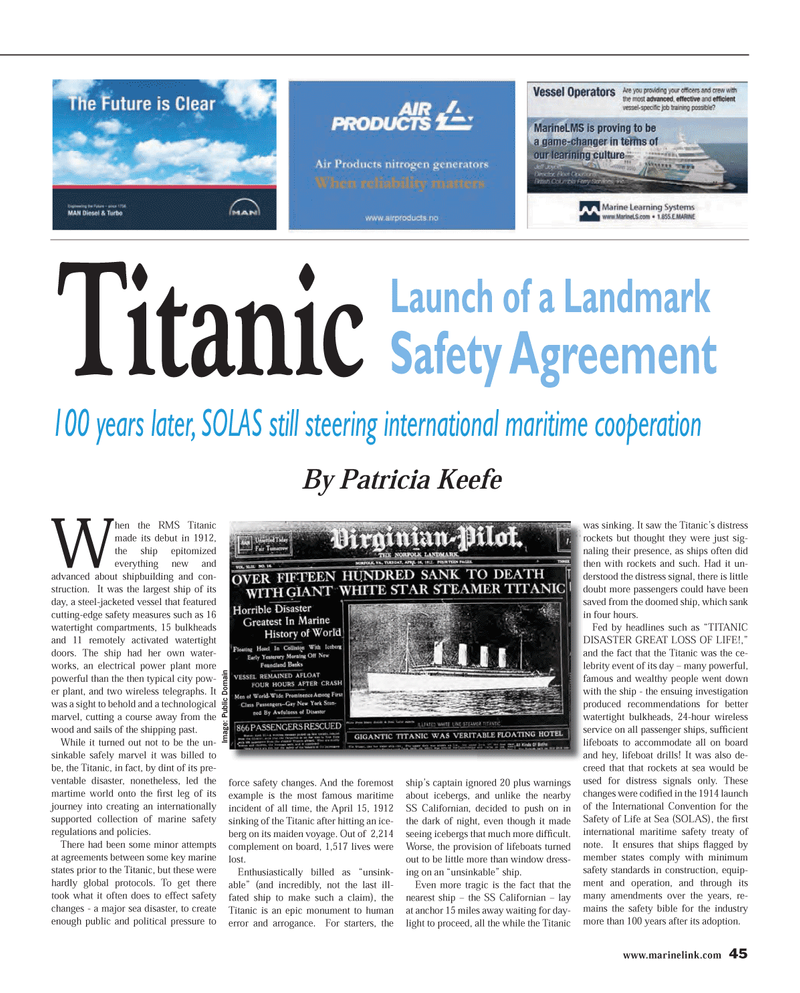
Page 45: of Maritime Reporter Magazine (June 2014)
Annual World Yearbook
Read this page in Pdf, Flash or Html5 edition of June 2014 Maritime Reporter Magazine
www.marinelink.com 45
Titanic 100 years later, SOLAS still steering international maritime cooperation
By Patricia Keefe
W hen the RMS Titanic made its debut in 1912, the ship epitomized everything new and advanced about shipbuilding and con- struction. It was the largest ship of its day, a steel-jacketed vessel that featured cutting-edge safety measures such as 16 watertight compartments, 15 bulkheads and 11 remotely activated watertight doors. The ship had her own water- works, an electrical power plant more powerful than the then typical city pow- er plant, and two wireless telegraphs. It was a sight to behold and a technological marvel, cutting a course away from the wood and sails of the shipping past.
While it turned out not to be the un- sinkable safely marvel it was billed to be, the Titanic, in fact, by dint of its pre- ventable disaster, nonetheless, led the martime world onto the ? rst leg of its journey into creating an internationally supported collection of marine safety regulations and policies.
There had been some minor attempts at agreements between some key marine states prior to the Titanic, but these were hardly global protocols. To get there took what it often does to effect safety changes - a major sea disaster, to create enough public and political pressure to force safety changes. And the foremost example is the most famous maritime incident of all time, the April 15, 1912 sinking of the Titanic after hitting an ice- berg on its maiden voyage. Out of 2,214 complement on board, 1,517 lives were lost.
Enthusiastically billed as “unsink- able” (and incredibly, not the last ill- fated ship to make such a claim), the
Titanic is an epic monument to human error and arrogance. For starters, the ship’s captain ignored 20 plus warnings about icebergs, and unlike the nearby
SS Californian, decided to push on in the dark of night, even though it made seeing icebergs that much more dif? cult.
Worse, the provision of lifeboats turned out to be little more than window dress- ing on an “unsinkable” ship.
Even more tragic is the fact that the nearest ship – the SS Californian – lay at anchor 15 miles away waiting for day- light to proceed, all the while the Titanic was sinking. It saw the Titanic’s distress rockets but thought they were just sig- naling their presence, as ships often did then with rockets and such. Had it un- derstood the distress signal, there is little doubt more passengers could have been saved from the doomed ship, which sank in four hours.
Fed by headlines such as “TITANIC
DISASTER GREAT LOSS OF LIFE!,” and the fact that the Titanic was the ce- lebrity event of its day – many powerful, famous and wealthy people went down with the ship - the ensuing investigation produced recommendations for better watertight bulkheads, 24-hour wireless service on all passenger ships, suf? cient lifeboats to accommodate all on board and hey, lifeboat drills! It was also de- creed that that rockets at sea would be used for distress signals only. These changes were codi? ed in the 1914 launch of the International Convention for the
Safety of Life at Sea (SOLAS), the ? rst international maritime safety treaty of note. It ensures that ships ? agged by member states comply with minimum safety standards in construction, equip- ment and operation, and through its many amendments over the years, re- mains the safety bible for the industry more than 100 years after its adoption.
Launch of a Landmark
Safety Agreement p
Image: Public Domain
MR #6 (40-49).indd 45 5/29/2014 9:26:48 AM

 44
44

 46
46
